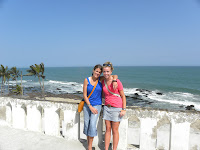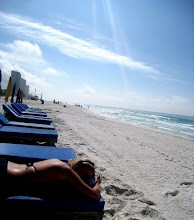

Our tour was eye opening. What I did not realize was that the castles were the dungeons. We toured the infamous Cape Coast Castle built by the Swedes in 1653 and Elmina Castle built by the Portuguese in 1482. Each held the governors and military men of the western empires. The bottom level was the holding pen for the slaves. Our guide told us horrific stories of the conditions of the dungeons. He led us through the door of no return where Africans would take their last glimpse of their homeland as they boarded the ship that would take them somewhere in the new world. From the governor’s terrace we stared down at an open plaza. Here all female slaves were to stand on dismay for the governor to choose a bedmate. If they refused they were chained to the ground and kept under the hot sun with no food or water for all to see and learn to obey. We were taken into a room that had no sunlight and one hole of ventilation. Above it was a skull and crossbones. This is where certain slaves were taken and kept until they died a horrible death because they were given no provisions. We were told that sharks would follow the slave ships because they learned that fresh meat was always available when someone died, misbehaved, or was found pregnant due to the dungeon rapes. Ironically in the middle of one of the dungeon courtyards was a church. I found it unbelievable that a community lived within the moat protected castle walls and paid no heed to the humans kept like animals around them. Also, as Katie and I sat on a cannon and looked at the blue water, the tranquil waves, and the ease of the local fishermen coming and going in their handmade boats, it made me sad that such a beautiful place was scarred by it’s history.
The cape coast market place was the busiest market I have ever seen. A professor speculated that there were probably hundreds of thousands of people buy and selling and fishing and working in this area. This fishing village provides for much of Southern Ghana so people from all over come here to buy for their community. (This gave me a weird feeling as I remembered the fish being sold at that first market- how far did they travel unrefrigerated? How old were those fish? ) The area was striking. There was so much color: the fishing boats symbolically decorated with different patterns and colors, the flag waving marking different vending areas, and the fabrics worn by everyone there. I desperately wanted to get out and explore. Alas, as the bus continued, I was confined to my imagination wandering down the docks, beaches, talking to different locals, taking it all in.
Meena Gets Anotha Lova
Although tired and anticipating an early alarm the next morning, we went out. The phrases “C’mon we are only in ____ once” and “When will we ever get the chance to do ____ in ______ again?” are always in the back of my mind urging me to take advantage of every opportunity and I never regret it. At the Venus Café a hoard of SAS students gathered and intermingled with locals. Meena and I sat at a table that looked like a lacquered tree stump and chatted about our day’s experiences. We were approached by two (of course, friendly) Ghanaians. One noticed my new bracelet and told Meena she should have one. Great, more vendors. He put one of his bracelets on Meena, she refused, but he told her it was a gift. This is Meena’s second gift from a foreign boy. We chatted with them about our plans to head down to the beach for reggae night. We allowed them to buy us Stars. When they became too friendly we made up a story and left. They followed us! We assured them we’d see them at the beach but headed back to the ship. Two free stars and a bracelet for Meena. Success.


No comments:
Post a Comment